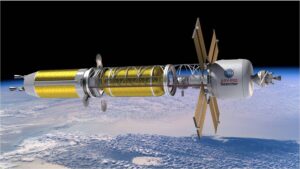Report recommends NASA accelerate space nuclear propulsion development
By Jeff Foust

WASHINGTON — NASA needs to pursue “aggressive” development of space nuclear propulsion technologies if the agency wants to use them for human missions to Mars in the next two decades, a report by a National Academies committee concluded.
A Feb. 12 study by the National Academies, sponsored by NASA, said both nuclear thermal propulsion (NTP) and nuclear electric propulsion (NEP) approaches must overcome significant hurdles for their use in a notional 2039 human mission to Mars. Such systems could reduce the travel time of expeditions to Mars.
“Space nuclear propulsion technology shows great potential to facilitate the human exploration of Mars,” said Bobby Braun, director for planetary science at the Jet Propulsion Laboratory and co-chair of the committee that wrote the report, in a statement. “However, significant acceleration in the pace of technology maturation is required if NASA and its partners are to complete this mission within the stated timeline.”
Of the two technologies, the report was more optimistic about NTP, where a nuclear reactor heats up a fuel such as liquid hydrogen to generate thrust. “An aggressive program could develop an NTP system capable of executing the baseline mission in 2039,” the report concluded.
That technology, though, faces several challenges beyond the nuclear reactor itself. They include being able to heat up the propellant to the required temperature of 2,700 kelvins and bringing the system up to operating temperature within one minute. Other challenges include a lack of ground-based testing facilities for NTP systems and difficulties storing liquid hydrogen for the duration of a mission.
NEP, where a nuclear reactor generates power for electric thrusters, needs to scale up its power and thermal management systems to levels far beyond what’s been demonstrated to date in order to work with megawatt-class reactors. The report, though, noted there has been little progress on relevant technologies since 2005, and the work that has been done has been limited to lower-power systems.
“As a result of low and intermittent investment over the past several decades, it is unclear if even an aggressive program would be able to develop an NEP system capable of executing the baseline mission in 2039,” the report concluded. It nonetheless recommended NASA “invigorate technology development” for NEP systems.
NASA has been struggling to balance competing priorities for nuclear power and propulsion development. In addition to NTP and NEP, the agency has also been working on surface fission power systems, such as Kilopower, that would provide power on the surface of the moon or Mars. The agency has tried to advance work on Kilopower because that technology has nearer-term applications for the Artemis lunar exploration program, which doesn’t need nuclear propulsion.
Congressional advocates of NTP, though, have inserted report language into appropriations bills directing NASA to spend money on that effort. That includes the fiscal year 2021 appropriations bill enacted in December, which instructed NASA to spend $110 million of its $1.1 billion in space technology funding on NTP development, of which $80 million would go “the design of test articles that will enable a flight demonstration.” NASA has not announced plans yet for a flight demonstration of an NTP system.
At a Jan. 27 meeting of the NASA Advisory Council’s technology committee, members noted that they had previously advised NASA to make surface fission power a higher priority than NTP because of its applications for Artemis.
“Absolutely. We totally agree,” Jim Reuter, NASA associate administrator for space technology, responded. “The direction from Congress was nuclear thermal propulsion.” He said NASA was moving ahead with a solicitation for NTP technology development because of the funding, delaying one for surface nuclear power until later in the fiscal year.
“Nuclear thermal propulsion has high interest from a number of standpoints, both NASA and DOD,” he added. “It is a very good technology.”
The Trump administration, in its final weeks, also elevated surface nuclear power over NTP and NEP. Space Policy Directive 6, released Dec. 16, established a strategy for developing space nuclear technologies, including both power and propulsion. It prioritized surface nuclear power over nuclear propulsion because the latter is not needed for the Artemis program.
“Those things are important for going to Mars,” a senior administration official said of nuclear propulsion at the time of the strategy’s release, “but first we’re doing the moon and leveraging terrestrial capabilities and technologies to put that foothold on the moon.”
It’s not clear what relevance that strategy has under the Biden administration, which has taken few measures yet regarding space policy.
February 13, 2021 at 12:18AM
via SpaceNews read more...

Post a Comment